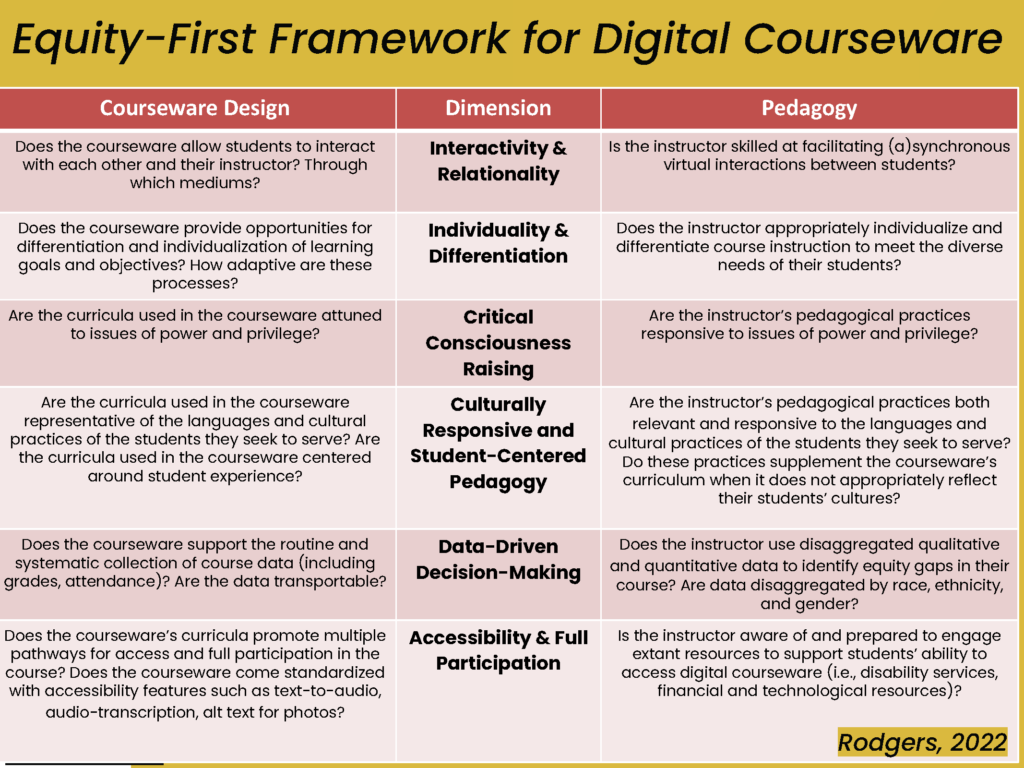Aireale J. Rodgers says equity is too often treated as an afterthought in the design and implementation of digital learning. Supporting historically marginalized students requires starting from an explicitly equity-minded perspective.
Toward that end, Rodgers, a postdoctoral research fellow at the University of Wisconsin-Madison, developed an equity-first framework using six considerations for designers and instructors seeking to leverage courseware as a tool to support equitable and just student learning. She presented and outlined that framework in An Equity-First Approach to Postsecondary Digital Learning in February 2023, part of Every Learner Everywhere’s webinar series, Strategies for Success Through Equitable Teaching and Learning.
“From my perspective, racial equity issues are life or death issues because of the ways our society still disproportionately puts Black, Indigenous, and other people of color at risk for premature death,” Rodgers says. “So thinking about ways in which racial bias quite literally kills people provides a very powerful imperative for why we must transform the way we are centering equity in our work.”
As Rodgers points out, our culture either awards privilege and legitimacy or legitimizes oppression based on people’s racial and other identities. “We think about race alongside socio-economic status, disability, gender, sexuality, sexual orientation, citizenship, to name a few,” she says. “The way all these social categorizations confer privilege or oppression is what we need to pay attention to in our work.”
1. Interactivity and relationality
The first step in the equity-first framework asks if the courseware a class is using allows students to interact with each other and their instructor and if the instructor is skilled at facilitating interaction in virtual environments.
“We have tremendous evidence that social interactions are powerful mediators of learning, especially for students of color,” Rodgers says, and digital learning platforms have redefined the notion of educational community.
“So how do we create bonds and intellectual kinship? One idea is to invite students to create introductions right before the start of the course, using a platform like Vimeo. I did that in an online course with many students living in different states, and it was a fun way to really humanize each other — and myself — as the instructor.”

illustration. Slide 13 from Rodgers’ presentation.
2. Individualization and differentiation
Does the courseware provide opportunities to tailor learning goals and objectives to meet the needs of a diverse group of students?
“Oftentimes when I talk about differentiation and individualization with people,” Rodgers says, “it’s like, ‘Well Aireale, I got 30 students in my class. I ain’t got time to think about 30 different assignments.’ But I think there are ways to partner with students that allow them to express their unique brilliance. One thing I ask them is what excites you about what we’re going to learn together.”
Another strategy is to be flexible about the ways students can demonstrate mastery of subject matter and apply it to real world scenarios. “Is it only a five- to 10-page essay, or could someone script a podcast episode?”
3. Critical consciousness raising
The third stage of the equity-first framework asks if the curricula or material in the courseware and the instructor are attuned to issues of power and privilege.
She refers to the educator and philosopher Paulo Freire’s description of critical consciousness raising as learning to perceive social, political, and economic inequities and intervene against oppressive forces that perpetuate them. “The goal is directly related to the liberatory role of pedagogy and its ability to address real world consequential problems,” she says.
Applying critical consciousness within a particular discipline, marginalized students can connect the subject to their own lived experiences. “In a statistics course, there are certain equations students need to master,” Rodgers says. “But a perspective of critical consciousness raising begs us to ask the question: Toward what end? What are they supposed to do with this information?”
Embedding critical consciousness in course design, she adds, might include telling the origin story of the field. “Where does power lay within that story? Who is or who is not considered part of the canon? What does that mean for students’ learning to use the tools of the discipline toward transformative ends — or continuing a status quo?”
4. Culturally responsive and student-centered pedagogy
Next, the equity-first framework asks if the curricula and materials in a courseware product is representative of the languages and cultural practices of the students they seek to serve. Is it centered around student experience?
“Culturally responsive student-centered pedagogy demands that you know your students, so throughout the semester you work to earn your students’ trust, know their passions, curiosities, and histories,” Rodgers says. “You might do that one-on-one; a professor I saw had questions cut up in a bowl to start the first class session. Students really seem to enjoy learning more about each other, as well as bringing parts of themselves to their understanding of course content.”
5. Data-driven decision making
Does the courseware support the routine and systematic collection of course data? Does the instructor use disaggregated student data — by race, ethnicity, and gender, for example — to identify equity gaps in their course?
“One benefit of digital courseware is that there is data gathering and data analytics embedded within it,” Rodgers says. “Something I’m still working through is trying to figure out how we make large data sets digestible and interpretable for instructors.”
Disaggregating data by demographics, she adds, means “taking a large data set and saying, okay, here’s the overall picture but, if I am thinking about a particular population or folks with particular lived experiences within that data set, how am I being attentive to some of the distinctions, patterns, themes, and disparities?”
6. Accessibility and full participation
Equity-first approaches to digital learning require asking whether curricula promote multiple pathways for access and full participation. Does the courseware come standardized with accessibility features such as text-to-audio, audio-transcription, and alt text for photos?
“It’s incumbent upon us to proactively find ways to mitigate access challenges for our students,” Rodgers says. One way for instructors to achieve that goal is to become familiar with campus and community resources that promote so-called disciplinary identity — when students become immersed in and connected to their chosen field. “So, if you’re teaching a biology course, it means really supporting students so that they see themselves as becoming biologists.”
As Rodgers points out, these, and other equitizing strategies, help “create learning environments where everyone can engage, especially those who have historically not been afforded the opportunity to fully participate in the ways that they deserve.”
See the Every Learner archive of workshops on digital learning and equity

